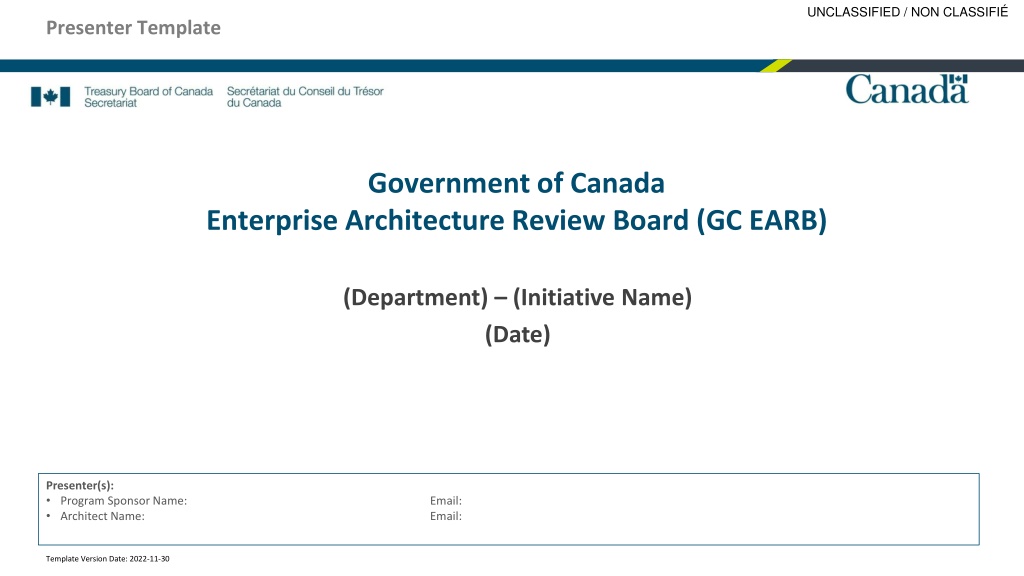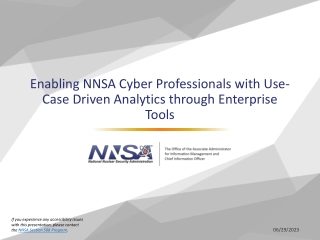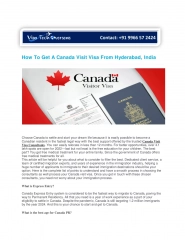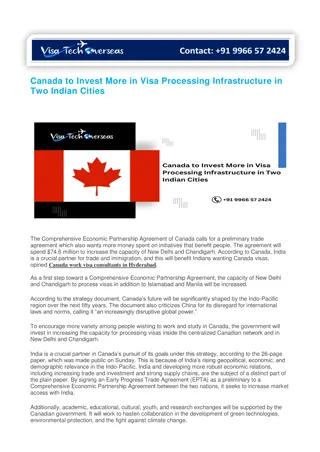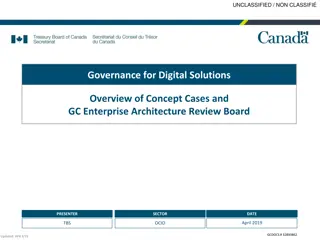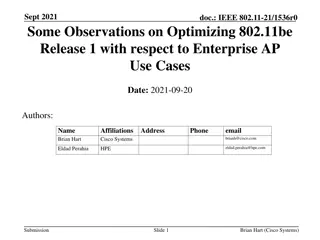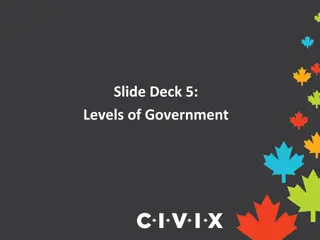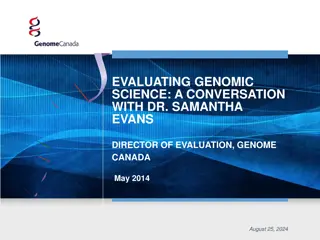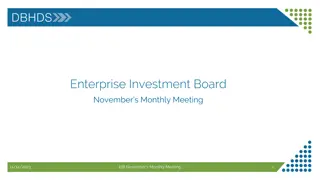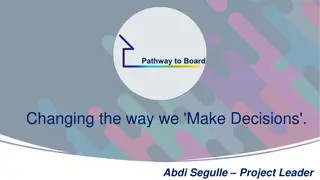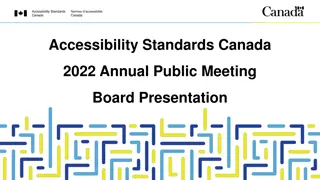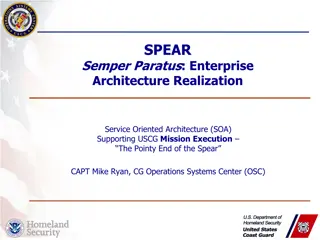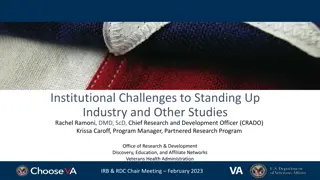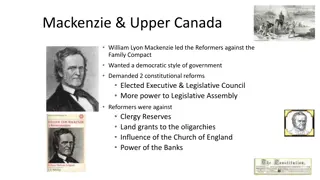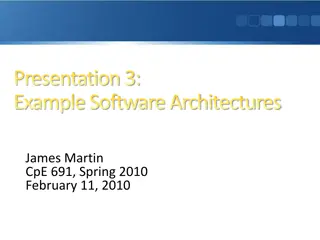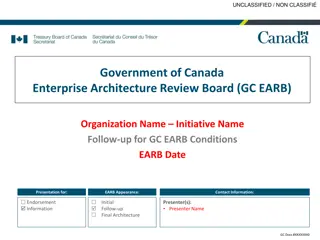Government of Canada Enterprise Architecture Review Board Presentation
This presentation seeks endorsement from the GC.EARB for the architecture of a digital initiative in a specific department. It addresses departmental policies, business problems, and GC business capabilities. The content includes diagrams and details related to the initiative.
Download Presentation

Please find below an Image/Link to download the presentation.
The content on the website is provided AS IS for your information and personal use only. It may not be sold, licensed, or shared on other websites without obtaining consent from the author. Download presentation by click this link. If you encounter any issues during the download, it is possible that the publisher has removed the file from their server.
E N D
Presentation Transcript
UNCLASSIFIED / NON CLASSIFI Presenter Template Government of Canada Enterprise Architecture Review Board (GC EARB) (Department) (Initiative Name) (Date) Presenter(s): Program Sponsor Name: Architect Name: Email: Email: Template Version Date: 2022-11-30
UNCLASSIFIED / NON CLASSIFI Purpose of GC EARB Session The purpose of this presentation is to seek (initial/follow-up/final) GC EARB endorsement of the (conceptual/interim/target) architecture for the (department name) (digital initiative name) solution. (Please indicate if this is in support of an upcoming TB Submission. ) IF for Follow-up: Past GC EARB date: Condition(s): 2
UNCLASSIFIED / NON CLASSIFI Request Background Describe which departmental policies, programs and business services the presentation is addressing. Include a summary of the business problem or opportunity statement as described in the Concept Case Summary of environmental scan findings related to the problem/opportunity 3
UNCLASSIFIED / NON CLASSIFI Business Capabilities Addressed Business Capabilities List the GC Business capabilities addressed (Level 2) Example List of Departmental Business capabilities addressed (if applicable) 1. Legislation, Regulation and Policy Management 1.3 Policy Management 3.1 Strategic Policy Management 2. Enterprise Planning 2.3 Program and Service Planning 3.2 Program Management 3. Outcomes Management 3.2 Performance Management 3.3 Reporting Framework Management 2.5 Departmental Performance Management 8.1 Service Quality Assurance 8.2 Service Efficiency Assurance 11.7 Corporate Reporting 4. Relationship Management 4.1 Stakeholder Awareness Management 4.2 Stakeholder Information Management 4.3 Stakeholder Interaction Management 5.1 Client Intelligence Management 5.2 Client Awareness Management 5.3 Client Engagement Management 5.4 Client Management 5.5 Client Communications Management 7.2 Partner Relationship Management 5. Compliance Management 5.1 Compliance and Investigation Management 9.1 Client Compliance 9.3 Investigation Management 6. Program and Service Delivery 6.1 Agreements Management 6.4 Dispute Resolution Management 6.7 Authorization Management 6.8 Payment Management 6.1 Service Enrollment Management 6.3 Payment Management 6.4 Credential Management 6.6 Knowledge Discovery Management 6.9 Appeals & Dispute Resolution Management 7. Information Management 7.1 Information Lifecycle Management 7.3 Research and Knowledge Management 10.5 Information Management 8. Government Resources Management 8.2 Financial Management 8.3 Human Resources Management 8.5 Technology Management 8.6 Work Management 10.1 Financial Management 10.4 Human Resources Management 10.6 Technology Management 6.2 Service Workflow & Workload Management 9. Corporate Management 9.1 Security Management 9.3 Business Transformation Management 4.2 Change Design Management 4.3 Change Implementation Management 11.1 Security Management 4
UNCLASSIFIED / NON CLASSIFI Business Process / Information / Data Flow Diagram Example 5
UNCLASSIFIED / NON CLASSIFI Current State Architecture Problem Summary Architecture Layer Key elements and issues for each layer Example Reduced business efficiency and poor user experience from integrating and maintaining multiple solutions. Need to enable off network, off VPN management of information to support staff who work in the field - at borders, at industry sites for inspections, etc. Business Information and data duplication and transit across the multiple solutions with associated compliance and productivity risks. Information EDRM application sprawl increasing the licensing costs, interoperability requirements and manual maintenance Application Maintaining and supporting multiple technology platforms (GCdocs, shared drives; RDIMS, EDMS, proliferation of OneDrive) Technology Administration, permission management, access controls and monitoring are all made more complex by having multiple platforms, processes, toolsets and resource pools. Security 6
UNCLASSIFIED / NON CLASSIFI Current State Architecture Diagram Example 7
UNCLASSIFIED / NON CLASSIFI Target State Architecture Diagram Example 8
UNCLASSIFIED / NON CLASSIFI Target State Architecture Solution Summary Architecture Layer Key elements and solutions for each layer Example Improved user experience Reduced cost of ownership Alignment with TBS Policy Legal position to meet recordkeeping obligations Business Centralized management of information assets for HC and PHAC with IA practices evolved from previous EDRM instances and new SStMI. Business enablement via off network/vpn access to information. Information Cost savings related to reduction in number of existing corporate repositories Application Single cloud-based technology platform Technology Using approved solutions and M365 ICAM and security features Security 9
UNCLASSIFIED / NON CLASSIFI Summary of architecture/solution options and evaluation results Solution Options: Example 1 2 3 4 5 ePost Connect LiquidFiles (on-prem) LiquidFiles (Cloud) SharePoint OneDrive Azure Blob Storage Evaluation Criteria: Enterprise and GC Architecture Fit 3 3 4 4 2 Key Feature Support X 4 4 X 4 User Experience 3 4 4 4 3 Implementation Effort 3 4 3 3 0 Scalability 4 3 4 4 4 Security 3 4 4 4 4 License and Security Costs 3 4 3 4 3 Long-term Viability 3 3 3 4 3 Total Score X 29 29 X 23 Recommended Option: Yes Yes Rating Interpretation 4 Fully The option fully meets the expectations defined by the criterion. 3 Mostly The option almost completely meets the expectations defined by the criterion. 2 Partially The option only partially meets the expectations defined by the criterion. 1 Poorly The option does a poor job of meeting the expectations defined by the criterion. 0 None The option does not meet the expectations defined by the criterion. X Non-Compliant The option is non-compliant regarding a given mandatory criterion. 10
UNCLASSIFIED / NON CLASSIFI GC EA Summary TBS Assessor: To be completed by EA Layer Summary Assessment of each layer Alignment Business Fully TBS EA Assessor Information Fully Application Partially Technology Partially Security Not GC EA Recommendation and Proposed Conditions 11
UNCLASSIFIED / NON CLASSIFI Enterprise Solution EA Recommendation To be completed by TBS Assessor: Facet Summary Alignment (Please identify what is ready what is not) Governance Fully TBS EA Assessor Culture Partially Solution Not GC EA Recommendation 12
UNCLASSIFIED / NON CLASSIFI Glossary List of Acronyms Used In This Presentation Acronym Definition CASB Cloud Access Security Broker CSP Cloud Service Provider EDC Enterprise Data Centre LDC Legacy Data Centre GC-CAP GC Cloud Access Points GC-TIP GC Trusted Interconnection Points 13
UNCLASSIFIED / NON CLASSIFI Appendix 1: GC EA Framework Business Architecture Business architecture is a critical aspect for the successful implementation of the GC Enterprise Ecosystem Target Architecture. The architectural strategy advocates whole of government approach where IT is aligned to business services and solutions are based on re useable components implementing business capabilities in order to deliver a cohesive user experience. As such, it is essential that business services, stakeholder needs, opportunities to improve cohesion and opportunities for reuse across government be clearly understood. In the past these elements have not been a priority. It is expected that the IT culture and practices will have to change to make business architecture, in general, and these elements a primary focus. B-1. Design services digitally from end to end to meet the Government of Canada users and other stakeholders needs HOW will this be achieved? Clearly identify internal and external users and other stakeholders and their needs for each policy, program and business service Include policy requirement applying to specific users and other stakeholder groups, such as accessibility, gender-based plus analysis, and official languages in the creation of the service Perform Algorithmic Impact Assessment (AIA) to support risk mitigation activities when deploying an automated decision system as per Directive on Automated Decision-Making Model end to end business service delivery to provide quality, maximize effectiveness and optimize efficiencies across all channels (for example, lean process) 14
UNCLASSIFIED / NON CLASSIFI Appendix 1: GC EA Framework Business Architecture - continued B-2. Architect to be outcome driven and strategically aligned to the department and to the Government of Canada HOW will this be achieved? Identify which departmental/GC business services, outcomes and strategies will be addressed Establish metrics for identified business outcomes throughout the life cycle of an investment Translate business outcomes and strategy into business capability implications in the GC Business Capability Model to establish a common vocabulary between business, development, and operation B-3. Promote horizontal enablement of the enterprise HOW will this be achieved? Identify opportunities to enable business services horizontally across the GC enterprise and to provide cohesive experience to users and other stakeholders Reuse common business capabilities, processes and enterprise solutions from across government and private sector Publish in the open all reusable common business capabilities, processes and enterprise solutions for others to develop and leverage cohesive horizontal enterprise services 15
UNCLASSIFIED / NON CLASSIFI Appendix 1: GC EA Framework Information Architecture Information architecture includes both structured and unstructured data. The best practices and principles aim to support the needs of a business service and business capability orientation. To facilitate effective sharing of data and information across government, information architectures should be designed to reflect a consistent approach to data, such as the adoption of federal and international standards. Information architecture should also reflect responsible data management, information management and governance practices, including the source, quality, interoperability, and associated legal and policy obligations related to the data assets. Information architectures should also distinguish between personal and non personal data and information as the collection, use, sharing (disclosure), and management of personal information must respect the requirements of the Privacy Act and its related policies. I-1. Collect data to address the needs of the users and other stakeholders HOW will this be achieved? Assess data requirements based program objectives, as well users, business and stakeholder needs Collect only the minimum set of data needed to support a policy, program, or service Reuse existing data assets where permissible and only acquire new data if required Ensure data collected, including from third-party sources, are of high quality 16
UNCLASSIFIED / NON CLASSIFI Appendix 1: GC EA Framework Information Architecture continued 1 I-2. Manage and reuse data strategically and responsibly HOW will this be achieved? Define and establish clear roles, responsibilities, and accountabilities for data management Identify and document the lineage of data assets Define retention and disposition schedules in accordance with business value as well as applicable privacy and security policy and legislation Ensure data are managed to enable interoperability, reuse and sharing to the greatest extent possible within and across departments in government to avoid duplication and maximize utility, while respecting security and privacy requirements Contribute to and align with enterprise and international data taxonomy and classification structures to manage, store, search and retrieve data I-3. Use and share data openly in an ethical and secure manner HOW will this be achieved? Share data openly by default as per the Directive on Open Government and Digital Standards, while respecting security and privacy requirements; data shared should adhere to existing enterprise and international standards, including on data quality and ethics Ensure data formatting aligns to existing enterprise and international standards on interoperability; where none exist, develop data standards in the open with key subject matter experts Ensure that combined data does not risk identification or re identification of sensitive or personal information 17
UNCLASSIFIED / NON CLASSIFI Appendix 1: GC EA Framework Information Architecture continued 2 I-4. Design with privacy in mind for the collection, use and management of personal Information HOW will this be achieved? Ensure alignment with guidance from appropriate institutional ATIP Office with respect to interpretation and application of the Privacy Act and related policy instruments Assess initiatives to determine if personal information will be collected, used, disclosed, retained, shared, and disposed Only collect personal information if it directly relates to the operation of the programs or activities Notify individuals of the purpose for collection at the point of collection by including a privacy notice Personal information should be, wherever possible, collected directly from individuals but can be from other sources where permitted by the Privacy Act Personal information must be available to facilitate Canadians right of access to and correction of government records Design access controls into all processes and across all architectural layers from the earliest stages of design to limit the use and disclosure of personal information Design processes so personal information remains accurate, up-to-date and as complete as possible, and can be corrected if required De-identification techniques should be considered prior to sharing personal information In collaboration with appropriate institutional ATIP Office, determine if a Privacy Impact Assessment (PIA) is required to identify and mitigate privacy risks for new or substantially modified programs that impact the privacy of individuals Establish procedures to identify and address privacy breaches so they can be reported quickly and responded to efficiently to appropriate institutional ATIP Office 18
UNCLASSIFIED / NON CLASSIFI Appendix 1: GC EA Framework Application Architecture Application architecture practices must evolve significantly for the successful implementation of the GC Enterprise Ecosystem Target Architecture. Transitioning from legacy systems based on monolithic architectures to architectures that oriented around business services and based on re useable components implementing business capabilities, is a major shift. Interoperability becomes a key element, and the number of stakeholders that must be considered increases. A-1. Use open source solutions hosted in public cloud HOW will this be achieved? Select existing solutions that can be reused over custom built Contribute all improvements back to the communities Register open source software to the Open Resource Exchange A-2. Use software as a service (SaaS) hosted in public cloud HOW will this be achieved? Choose SaaS that best fit for purpose based on alignment with SaaS capabilities Choose a SaaS solution that is extendable Configure SaaS and if customization is necessary extend as open source modules A-3. Design for Interoperability HOW will this be achieved? Design systems as highly modular and loosely coupled services Expose services, including existing ones, through APIs Make the APIs discoverable to the appropriate stakeholders 19
UNCLASSIFIED / NON CLASSIFI Appendix 1: GC EA Framework Technology Architecture Technology architecture is an important enabler of highly available and adaptable solutions that must be aligned with the chosen application architecture. Cloud adoption provides many potential advantages by mitigating the logistical constraints that often negatively impacted legacy solutions hosted on premises. However, the application architecture must be able to enable these advantages. T-1. Use cloud first HOW will this be achieved? Adopt the use of the GC Accelerators to ensure proper security and access controls Enforce this order of preference: software as a service (SaaS) first, then platform as a service (PaaS), and lastly infrastructure as a service (IaaS) Fulfill cloud services through SSC Cloud Brokering Services Enforce this order of preference: public cloud first, then hybrid cloud, then private cloud, and lastly non cloud (on-premises) solutions Design for cloud mobility and develop an exit strategy to avoid vendor lock-in 20
UNCLASSIFIED / NON CLASSIFI Appendix 1: GC EA Framework Technology Architecture - continued T-2. Design for performance, availability and scalability HOW will this be achieved? Ensure response times meet user needs, and critical services are highly available Support zero-downtime deployments for planned and unplanned maintenance Use distributed architectures, assume failure will happen, handle errors gracefully, and monitor performance and behaviour actively Establish architectures that supports new technology insertion with minimal disruption to existing programs and services Control technical diversity; design systems based on modern technologies and platforms already in use T-3. Follow DevSecOps principles HOW will this be achieved? Use continuous integration and continuous deployments Ensure automated testing occurs for security and functionality Include your users and other stakeholders as part of the DevSecOps process, which refers to the concept of making software security a core part of the overall software delivery process 21
UNCLASSIFIED / NON CLASSIFI Appendix 1: GC EA Framework Security Architecture The GC Enterprise Security Architecture program is a government wide initiative to provide a standardized approach to developing IT security architecture, ensuring that basic security blocks are implemented across the enterprise as the infrastructure is being renewed. S-1. Build security into the system life cycle across all architectural layers HOW will this be achieved? Identify and categorize information based on the degree of injury that could be expected to result from a compromise of its confidentiality, integrity and availability Implement a continuous security approach, in alignment with Centre for Cyber Security s IT Security Risk Management Framework; perform threat modelling to minimize the attack surface by limiting services Apply proportionate security measures that address business and user needs while adequately protecting data at rest and data in transit Design systems to be resilient and available in order to support service continuity 22
UNCLASSIFIED / NON CLASSIFI Appendix 1: GC EA Framework Security Architecture continued S-2. Ensure secure access to systems and services HOW will this be achieved? Identify and authenticate individuals, processes or devices to an appropriate level of assurance, based on clearly defined roles, before granting access to information and services; leverage enterprise services such as Government of Canada trusted digital identity solutions that are supported by the Pan- Canadian Trust Framework Constrain service interfaces to authorized entities (users and devices), with clearly defined roles; segment and separate information based on sensitivity of information, in alignment with ITSG-22 and ITSG-38. Management interfaces may require increased levels of protection ImplementHTTPS for secure web connections and Domain-based Message Authentication, Reporting and Conformance (DMARC) for enhanced email security Establish secure interconnections between systems through secure APIs or leveraging centrally managed hybrid IT connectivity services S-3. Maintain secure operations HOW will this be achieved? Establish processes to maintain visibility of assets and ensure the prompt application of security related patches and updates in order to reduce exposure to vulnerabilities, in accordance with GC Patch Management Guidance Enable event logging, in accordance with GC Event Logging Guidance, and perform monitoring of systems and services in order to detect, prevent, and respond to attacks Establish an incident management plan in alignment with the GC Cyber Security Event Management Plan (GC CSEMP) and report incidents to the Canadian Centre for Cyber Security (CCCS) 23
UNCLASSIFIED / NON CLASSIFI Appendix 2: Enterprise Solution Framework (if applicable) Enterprise solutions definition Enterprise solutions are internal and external Government of Canada assets that can be re-used in and across multiple parts of the organization. Additional info: GC Enterprise Architecture/Enterprise Solutions - wiki (gccollab.ca) ES-1. Governance HOW will the questions for this facet be addressed? What are the roles and responsibilities and who decides who fills them? What is the financial and funding model for an enterprise solution? Which business capabilities should be addressed first? How will user expectations be addressed? What is the path to enterprise-wide adoption? 24
UNCLASSIFIED / NON CLASSIFI Appendix 2: Enterprise Solution Framework (continued) ES-2. Culture HOW will the questions for this facet be addressed? Is everyone ready to buy-in to enterprise solutions? How do we ensure participation? How will open and transparent input be gathered? What are the mind-set and skills needed to foster an enterprise solution culture? ES-3. Solutions HOW will the questions for this facet be addressed? Which business problem are we solving? Who can access the Enterprise Solution? What data and technology standards are required? Is the implementation secure enough? Will it always be reliably online? 25
UNCLASSIFIED / NON CLASSIFI Appendix 3: Shared Services Canada (SSC) Involvement SSC Scope What is the scope of work required by Shared Services Canada? When/How has SSC been involved in this project? What SSC Services are to be impacted or consumed? https://service.ssc-spc.gc.ca/en/services https://service.ssc-spc.gc.ca/en/services Include due dates for SSC deliverables. What are the dependencies and assumptions? (ex: authentication, cloud connectivity. If legacy Data Centre, which one and has capacity has been confirmed.) SSC Contact SSC BR number (if available) BR Number SSC Client Executive contact Name/Title SSC project contact Name/Title SSC architecture contact Name/Title (if available) 26
UNCLASSIFIED / NON CLASSIFI Appendix 3: Additional Technical Details required by Shared Services Canada (SSC) Solution s Security Profile (e.g. PBMM, PBHM, etc.) Network Name(s) (e.g. Science Network, GCNet, GCSI, etc.) Maximum Allowable Downtime (Unplanned) / Year (in hours) Expected Network Traffic: (Video, Audio, Data, Interactive) Availability Requirements: Med (95%), High (>=99 %) Sensitivity to Network Latency: (Very High, High, Medium, Low) Disaster Recovery Requirements: (None, Cold Site, Warm Site, Hot Site) Approximate number of users: Network Geographical Distribution: (Low, Moderate, Regional, National, Global spread) Authentication Method (DCAM, ICE/ECM, Sign-in Canada, Other) Hosting Solution(s): (Legacy DC, EDC, Cloud list all applicable) Workload migrating off legacy? 27
UNCLASSIFIED / NON CLASSIFI Appendix 3: Summary of Cloud Access Scenarios and Usage Profiles Note: The patterns describe the different types of flows that may occur within a cloud- based environment. More than one connection pattern may be applicable to the solution architecture presented. The associated characteristics of each of these connection patterns as listed in the GC Secure Cloud Connectivity Requirements document and the cloud usage profiles (slide 14 GC Connection Patterns) should be taken into consideration while identifying the applicable cloud access scenarios. Cloud Access Scenarios (Reference: GC Connection Patterns) Recommended GC Enterprise Security Services For Applicable Cloud Access Scenarios Non-GC Users GC Users Application/API CCCS Cyber Defense Services SSC SCED Services GC Cloud-Services Access from GC network Access from External network Access from External network Non-GC Service to cloud- based GC service On-prem GC service to cloud- based GC service Cloud-based to a Cloud-based services GC-TIP GC-CAP CASB Maple Tap A4, A5 A5 A2,A3 A1, A4, A5 Same CSP Different CSP Departmental SaaS A2 B2 C2 D4 D7 B1,B4 B2,B3 B1,B4 GC wide SaaS A3 B3 C3 D5 D8 D1 D2 IaaS/PaaS (No interconnection with LDC/EDC) A1 B1 C1 D3 - C1,C4 C2,C3 C1, C4 IaaS/PaaS (Interconnection with LDC/EDC) A4 (no external access) A5 (with external access) B4 C4 D6 D9 - D9 D3 D4,D5,D7,D8 D1,D2,D3,D6,D9 Please include the applicable cloud access scenario with brief description Solution Component User/system connections Cloud tenant/ environment Use Case Brief Description Target Solution Portal PaaS GC Program Users Dept. Azure Tenant GC user access to cloud-based GC service hosted in GC-approved Hyper-Scale IaaS/PaaS (with Interconnection and no external access). A4 Target Solution Portal PaaS Non-Dept./Non- GC Program Users Dept. Azure Tenant Non-GC user access to cloud-based GC service hosted in GC-approved Hyper-Scale IaaS/PaaS (with Interconnection) Application. C4 API Gateway On-prem GC Service Dept. Azure Tenant On-prem GC service to cloud-based GC service hosted in GC-approved Hyper Scale IaaS/PaaS (with interconnection and no external access). GC cloud-based systems required to interact with systems in GC data centres. D9 28
